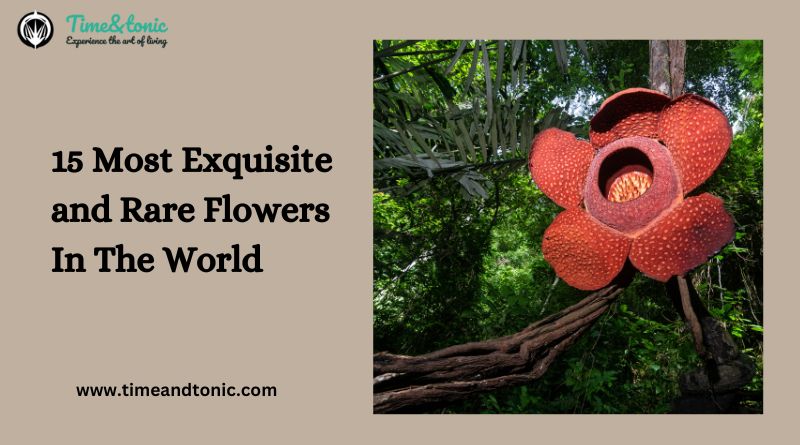15 Most Exquisite and Rare Flowers In The World
Welcome to our enchanting blog, where we’ll introduce you to the “15 Most Exquisite and Rare Flowers In The World.” These extraordinary blooms are like nature’s hidden treasures, each with its own unique story and beauty. From the dazzling Rainbow Eucalyptus to the delicate Lady’s Slipper Orchid, we’ll take you on a colorful journey to discover these rare gems. Some of these flowers are so elusive that they’re often found in remote corners of the globe, making them even more fascinating. We’ll uncover the secrets behind their rarity, share where you can find them, and why they are so cherished by plant enthusiasts and nature lovers alike. So, if you’re ready to be amazed by the incredible diversity of our planet’s floral wonders, join us on this captivating adventure through the world of rare and exquisite flowers.
Most Exquisite and Rare Flowers In The World
Discover a world of botanical marvels as we unveil the “15 Most Exquisite and Rare Flowers In The World.” Journey through the enchanting realms of nature’s most captivating blooms, each with its own unique charm and story.
The Corpse Flower (Rafflesia arnoldii)

The Corpse Flower, scientifically known as Rafflesia arnoldii, is a botanical wonder found in the rainforests of Sumatra, Indonesia. This unique flower earns its rather macabre name due to its unpleasant odor, which closely resembles the scent of a decomposing corpse. Despite its off-putting aroma, the Corpse Flower is a remarkable specimen, boasting some of the largest individual flowers in the plant kingdom.
Measuring up to three feet in diameter, the flower’s massive, red-tinged petals capture attention with their size and intricate patterns. What makes the Corpse Flower even more intriguing is its rare blooming pattern; it can take years for the bud to develop and then it remains in full bloom for only a few days.
Ghost Orchid (Dendrophylax lindenii)
The Ghost Orchid, scientifically named Dendrophylax lindenii, is a botanical enigma found in the swamps of Florida. What sets it apart from other orchids is its ethereal, ghostly appearance. It lacks conventional leaves, and its delicate, slender stems seem to defy gravity as they hover in mid-air, giving it an otherworldly quality. Its stark white petals and sepals contrast starkly with its deep green surroundings, adding to its mystique.
This orchid’s elusive nature adds to its allure. It’s notoriously difficult to spot in the wild, partly due to its preferred habitats in remote and often inaccessible locations. The Ghost Orchid’s unique charm has made it a prized find among orchid enthusiasts and photographers who undertake challenging journeys to catch a glimpse of its fleeting beauty. Its conservation is crucial, as it faces threats from habitat loss and illegal collection, reminding us of the fragility of nature’s most delicate and enchanting creations.
Kadupul Flower (Epiphyllum oxypetalum)
The Kadupul Flower, scientifically known as Epiphyllum oxypetalum, is a botanical marvel that hails from Sri Lanka. Often referred to as the “Queen of the Night,” this exquisite flower is renowned for its ephemeral beauty. What makes the Kadupul Flower truly remarkable is its unique flowering behavior – it blooms only at night and wilts before the break of dawn, lasting for just a few precious hours.
The flower’s pristine white petals and intoxicating fragrance enhance its allure. Its fragrance, reminiscent of jasmine, is said to be at its peak during the nighttime bloom, filling the air with a captivating scent. This natural spectacle has earned it a special place in Sri Lankan culture and mythology, symbolizing fleeting beauty and the impermanence of life.
Also Read- 5 Oxygen-Producing Indoor Plants
Jade Vine (Strongylodon macrobotrys)
The Jade Vine, scientifically known as Strongylodon macrobotrys, is a rare and captivating flowering plant native to the Philippines. This extraordinary vine is celebrated for its cascading clusters of vibrant turquoise flowers, which give it the nickname “Emerald Creeper.” The unique color of its blossoms and their long, hanging tendrils make it a botanical wonder.
One of the most intriguing aspects of the Jade Vine is its specialized pollination mechanism. It relies on bats, particularly fruit bats, for pollination. The flowers’ shape and color are adapted to attract these nocturnal pollinators, which play a crucial role in the plant’s reproduction.
Middlemist Red (Middlemist camellia)

The Middlemist Red, scientifically known as Middlemist camellia, is an exceptionally rare and striking flowering plant originally hailing from China. It holds the distinction of being one of the rarest flowers globally, making it a prized gem among botanists and plant collectors.
The Middlemist Red stands out with its vibrant and deep pink petals that form a lush, full bloom. Its intense coloration and lush appearance make it a sought-after ornamental plant, particularly in gardens and conservatories. However, its rarity has made it challenging to find, and only a few known specimens exist in the world.
Rothschild’s Slipper Orchid (Paphiopedilum rothschildianum)
Rothschild’s Slipper Orchid, scientifically named Paphiopedilum rothschildianum, is a captivating and highly coveted orchid species originating from the rainforests of northern Borneo. This extraordinary orchid is celebrated for its striking appearance, which resembles a lady’s slipper, hence its name. The Rothschild’s Slipper Orchid features distinctive characteristics, including large, vibrant petals and sepals that are intricately patterned with rich brown and green hues. Its unique and elegant form has made it a sought-after gem among orchid enthusiasts and collectors.
This orchid’s rarity, combined with habitat loss in its native region, has classified it as an endangered species. Conservation efforts are crucial to protect and preserve the Rothschild’s Slipper Orchid and its fragile natural habitat. The orchid serves as a testament to the captivating beauty and diversity of the orchid family, while also highlighting the importance of conservation to safeguard these unique and fragile botanical treasures for generations to come.
Parrot’s Beak (Impatiens psittacina)
Parrot’s Beak, scientifically known as Impatiens psittacina, is a fascinating and rare flowering plant that hails from parts of Southeast Asia. This unique flower has gained fame for its distinct and unusual shape, which strikingly resembles the beak of a parrot in flight.
The Parrot’s Beak flower features vibrant and eye-catching hues of red and orange, making it an attractive addition to gardens and collections. Its intriguing appearance has made it a subject of fascination for botany enthusiasts and those with an appreciation for unique botanical wonders.
However, the Parrot’s Beak is considered a threatened species due to habitat loss and environmental changes in its native regions. Conservation efforts are essential to protect this rare and extraordinary plant from further decline.
Youtan Poluo (Nelumbo nucifera)

Youtan Poluo, scientifically known as Nelumbo nucifera, is a tiny and extraordinary flowering plant that holds great significance in Buddhist culture. This unique aquatic plant is native to various parts of Asia and is revered for its rarity and spiritual symbolism.
What sets the Youtan Poluo apart is its exceptional blooming pattern. According to legend, it is believed to bloom once every 3,000 years, symbolizing purity and enlightenment. This rare and delicate flower emerges from the mud and water, representing the journey from darkness to enlightenment in Buddhist philosophy. Given its scarcity and profound symbolism, the Youtan Poluo holds a special place in Buddhist rituals and ceremonies. It’s often regarded as an auspicious symbol of purity, rebirth, and spiritual awakening.
Chrysanthemum Stone (Chrysanthemum indicum)
The Chrysanthemum Stone, scientifically known as Chrysanthemum indicum, is a geological wonder rather than a flowering plant. This unique stone, found in various parts of the world, gets its name from the intricate patterns within it, which closely resemble the petals of a chrysanthemum in full bloom.
What makes the Chrysanthemum Stone captivating is its detailed and delicate natural artistry. The stone’s surface is adorned with fine, radiating patterns that create a stunning floral-like arrangement. These patterns are the result of mineral deposits and other geological processes over millions of years. Collectors and enthusiasts treasure Chrysanthemum Stones for their aesthetic beauty and natural elegance. They are often used for ornamental purposes, including carving and sculpting, showcasing the exquisite patterns hidden within.
Saffron Crocus (Crocus sativus)
The Saffron Crocus, scientifically named Crocus sativus, is a remarkable and valuable flowering plant that has captivated humans for centuries. This plant is famous for being the source of saffron, one of the most expensive and sought-after spices globally. The Saffron Crocus blooms in the autumn, and each flower produces three bright red stigmas, which are meticulously hand-harvested. These stigmas are then dried to produce saffron, a spice renowned for its distinctive flavor, aroma, and vivid color. Saffron is used in various culinary dishes, perfumes, and traditional medicines, making it highly prized.
What adds to the allure of the Saffron Crocus is the labor-intensive process of saffron production. It takes tens of thousands of flowers to yield just one pound of saffron, making it one of the rarest and most expensive spices globally. The Saffron Crocus stands as a testament to the remarkable flavors and scents that nature can provide, while also highlighting the meticulous human efforts required to bring this botanical treasure to our tables and markets.
Juliet Rose (David Austin Roses)
The Juliet Rose, a creation of David Austin Roses, is a modern rose variety celebrated for its enchanting fragrance and exquisite peach-pink color. This particular rose has gained widespread recognition and acclaim for its exceptional beauty and unique qualities.
The Juliet Rose features lush, full blooms with layers of delicate petals that blend shades of soft apricot and blush pink. Its fragrance is equally captivating, often described as a delightful mix of myrrh and fruity notes, creating a truly sensory experience.
This rose variety has earned numerous awards and accolades, making it a beloved choice for weddings, special occasions, and floral arrangements. Its classic yet romantic appearance and intoxicating scent make it a standout in the world of roses.
Chocolate Cosmos (Cosmos atrosanguineus)

The Chocolate Cosmos, scientifically known as Cosmos atrosanguineus, is a distinctive and alluring flowering plant native to Mexico. What sets this flower apart is not only its deep maroon to nearly black color but also its enticing fragrance, which resembles that of dark chocolate.
The deep, velvety appearance of the Chocolate Cosmos flowers, combined with their rich chocolate-like scent, makes them a unique and sought-after addition to gardens and floral arrangements. Its bloom resembles a small, dark chocolate daisy, creating a visually striking contrast against green foliage. Sadly, in its native habitat, the Chocolate Cosmos is considered extinct and can now only be found in cultivation. Conservation efforts are crucial to preserve this captivating plant and its unique traits.
Black Bat Flower (Tacca chantrieri)
The Black Bat Flower, scientifically known as Tacca chantrieri, is an intriguing and exotic plant native to the tropical regions of Southeast Asia. This striking flower is famous for its dark, intricate petals that resemble a bat in flight, complete with long “whiskers” that can extend up to 28 inches. The flower’s dark purple to almost black coloration adds to its mystique, making it a favorite among collectors and enthusiasts of unusual and rare plants. Its dramatic appearance has earned it the nickname “Black Bat Flower” and makes it a captivating addition to gardens and botanical displays.
The Black Bat Flower’s unique and enigmatic appearance has also made it a subject of fascination in various cultures and a symbol of mystery and intrigue. It thrives in warm and humid climates and requires specific care to flourish, making it a cherished find for those with a passion for the extraordinary in the world of botany.
Singapore Orchid (Vanda Miss Joaquim)
The Singapore Orchid, officially recognized as Vanda Miss Joaquim, is a significant and captivating orchid that holds a dual distinction. It not only serves as the national flower of Singapore but is also admired globally for its rare and beautiful appearance.
The Vanda Miss Joaquim orchid stands out with its vibrant and striking purple-pink petals that form a resplendent and symmetrical bloom. Its exceptional beauty and resilience have made it a symbol of Singapore’s rich and diverse flora. This orchid has a fascinating history; it was first discovered in the garden of Agnes Joaquim in the late 19th century, and it eventually became an integral part of Singapore’s identity. Its hybrid nature, combining elements of two orchid species, adds to its uniqueness.
Rainbow Eucalyptus (Eucalyptus deglupta)
The Rainbow Eucalyptus, scientifically named Eucalyptus deglupta, is a mesmerizing and vibrant tree that originates from tropical regions, particularly in Southeast Asia, the Philippines, and Indonesia. What distinguishes this tree from others is its stunning and colorful bark, which gives it the name “Rainbow Eucalyptus.”
As the tree matures, strips of its bark peel away in layers, revealing a striking display of colors that resemble a rainbow palette. The colors include shades of green, blue, purple, orange, and maroon. This natural artwork on the tree’s trunk is a result of the shedding process and is unique to each tree. The Rainbow Eucalyptus is not only visually captivating but also ecologically important. It is valued for its timber, which is used in various construction and woodworking projects. Additionally, it serves as a habitat for a variety of wildlife.
Final Words
In the realm of nature’s beauty, these 15 exquisite and rare flowers transport us to a world of wonder and enchantment. From the intriguing Corpse Flower with its foul odor and enormous petals to the elusive Ghost Orchid that seems to float in the air, each of these floral wonders tells a unique story. The Kadupul Flower’s ephemeral beauty, the vibrant colors of the Jade Vine, and the rare elegance of the Middlemist Red remind us of the delicate balance between rarity and botanical artistry.
FAQs
Some of these rare flowers can be found in specialized nurseries or through collectors, but they may require specific care and conditions to thrive.
Yes, some rare flowers, such as the Youtan Poluo, have traditional medicinal uses in certain cultures, often linked to their unique properties and symbolism.
Many of these flowers have specific habitat requirements, and recreating those conditions can be a significant challenge for gardeners and enthusiasts.
Yes, numerous organizations and botanical gardens are actively engaged in conservation initiatives to protect these rare flowers from extinction.
Some botanical gardens and conservatories may feature these rare flowers in their collections, providing opportunities for the public to admire their beauty.



